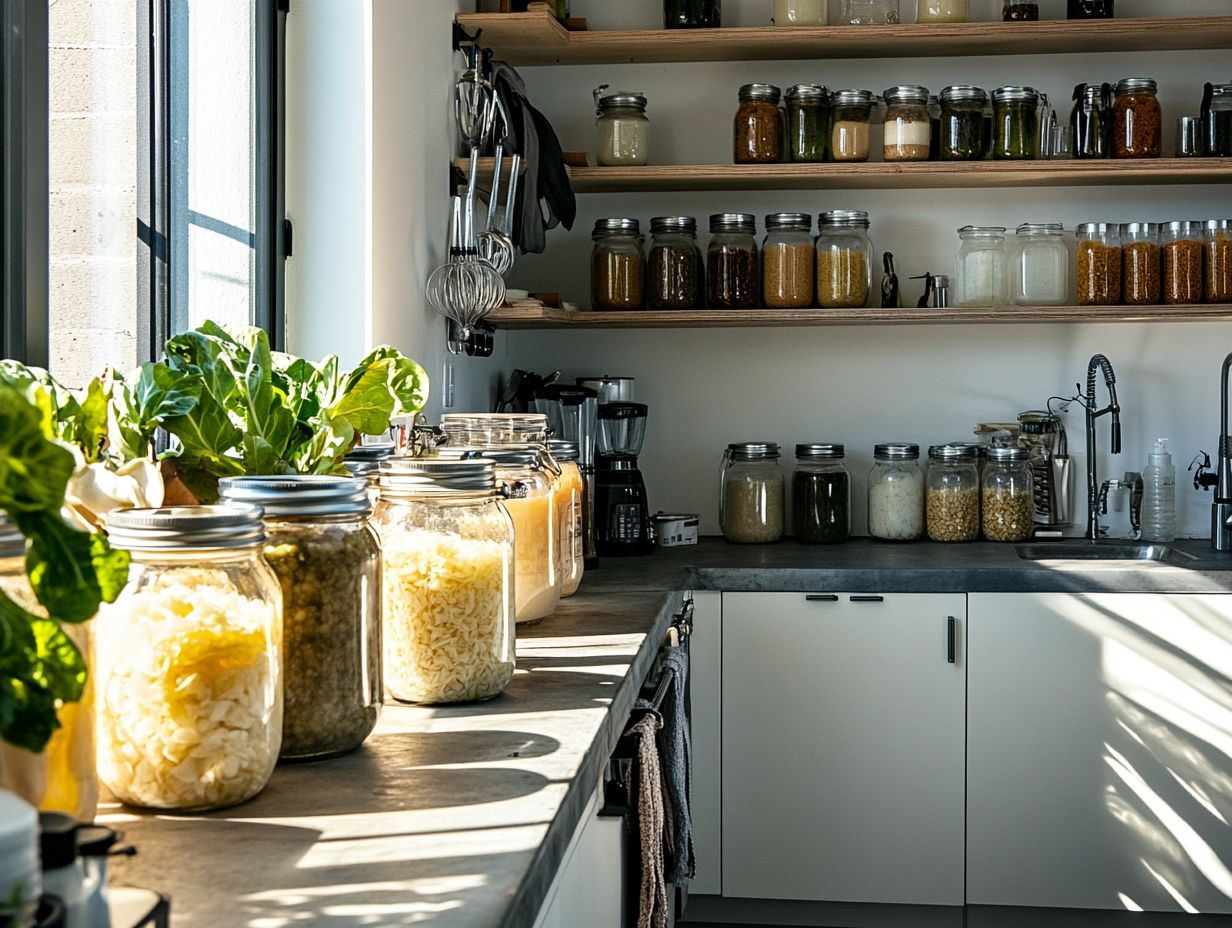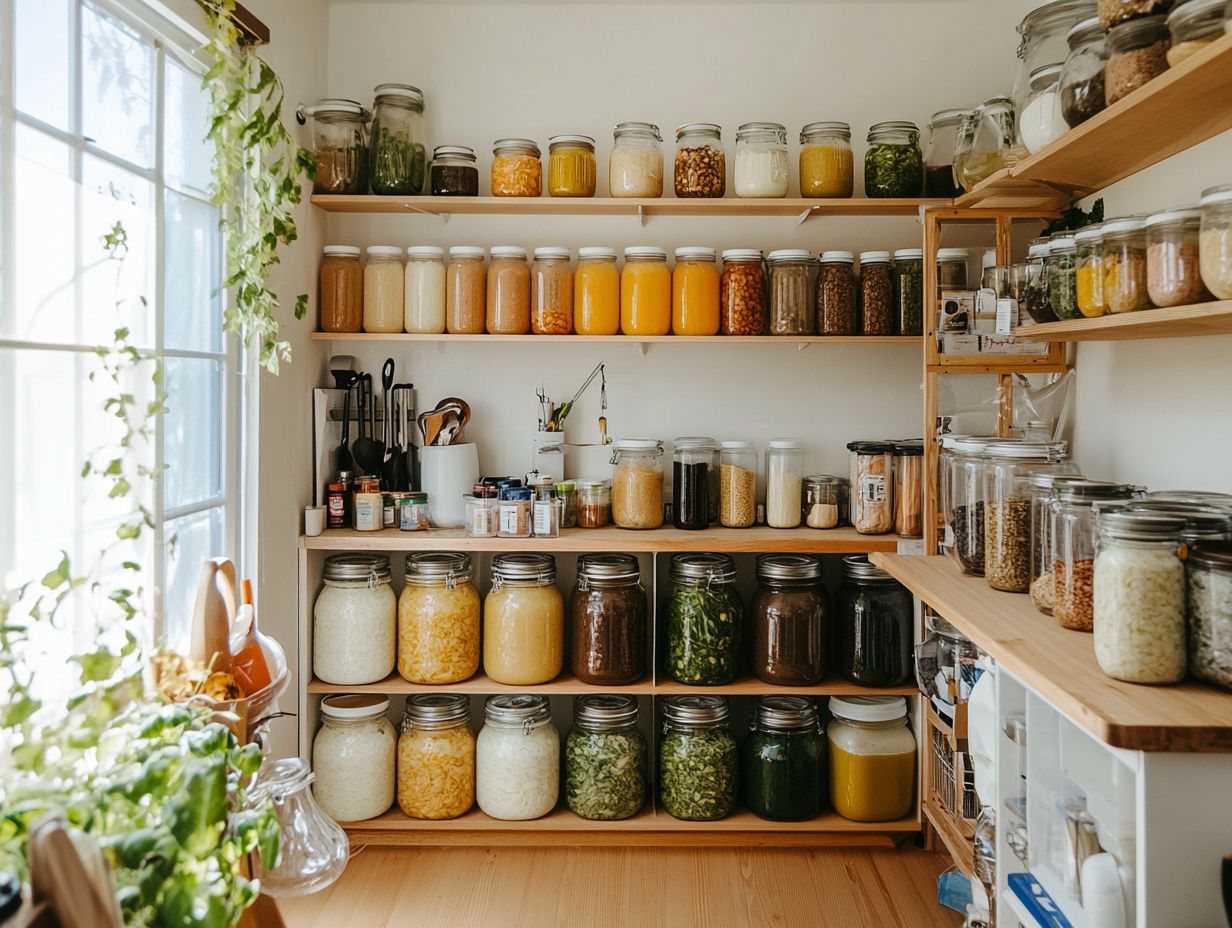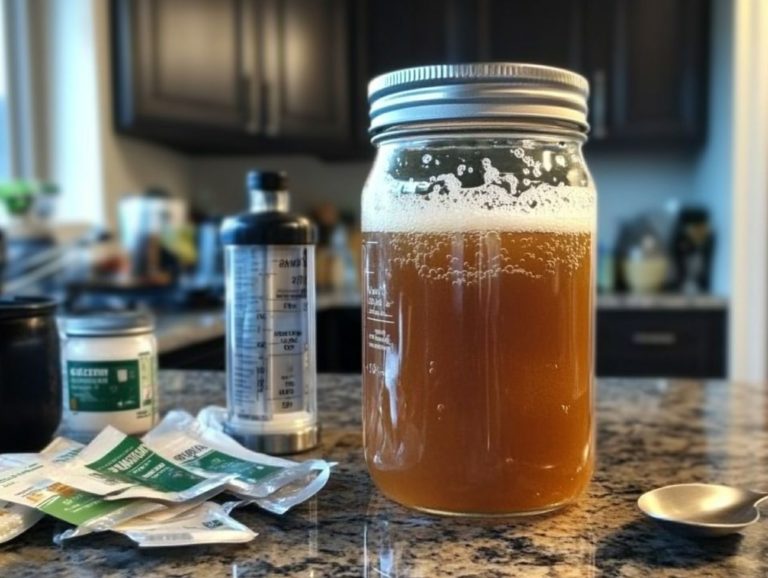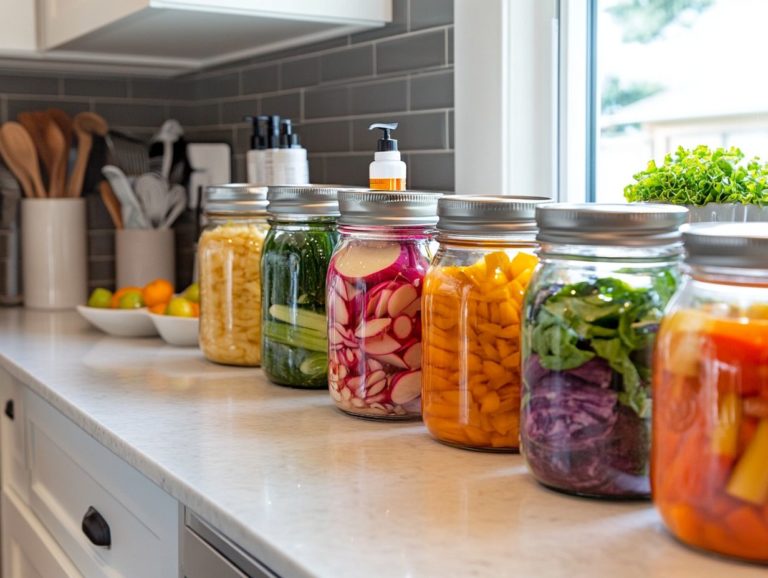The Best Practices for Fermentation Management
Fermentation is an intriguing process that elevates simple ingredients into a symphony of extraordinary flavors and textures, becoming a cornerstone of keeping food fresh. Get ready to dive in with careful management, keen attention to detail, and tried-and-true fermentation techniques!
This article explores essential aspects of fermentation management, including temperature control, pH monitoring, and oxygen management. You will discover best practices for achieving optimal results, helpful tips for home cooking, troubleshooting common challenges, and ensuring a truly rewarding fermentation journey.
Prepare to unlock the secrets to mastering the art of fermentation, with insights into recipes and techniques used by renowned chefs!
Contents
- Key Takeaways:
- The Basics of Fermentation Management
- 2. Monitoring pH Levels
- 3. Managing Oxygen Exposure
- 4. Maintaining Sanitation
- Best Practices for Successful Fermentation Management
- Fermentation Essentials
- Troubleshooting Common Fermentation Issues
- 3. Unusual Odors
- Final Thoughts on Fermentation Management
- Key Influencers in Fermentation
- Frequently Asked Questions
- What are the best practices for fermentation management?
- Why is sanitation important in fermentation management?
- How can temperature control affect fermentation management?
- What is the role of oxygen management in fermentation management?
- Why is monitoring pH levels necessary in fermentation management?
- What are the benefits of following best practices for fermentation management?
Key Takeaways:

- Consistent temperature control is crucial for successful fermentation management, influencing everything from kimchi to pickling.
- Use quality ingredients to ensure success, along with proper equipment like fermentation vessels and detailed record-keeping.
- Regular monitoring and adjusting are necessary for avoiding common fermentation issues and enhancing nutrient addition during fermentation.
The Basics of Fermentation Management
Understanding the basics of fermentation management is essential for home cooks eager to dive into the fascinating world of fermented foods. This ancient food-preservation technique enhances flavors, boosts nutrients, and introduces beneficial bacteria into your diet. Whether you re exploring fermentation basics or advanced techniques, the benefits are multifaceted.
Mastering fermentation requires careful attention to several key factors. These include selecting the freshest ingredients and choosing the right fermentation vessels. Employing appropriate techniques ensures both safety and exceptional taste. Essentials such as a clean vessel and a solid understanding of the fermentation process play significant roles.
Whether you’re crafting classic kimchi or half sour pickles, sourcing quality ingredients from places like Korean markets will lead to delicious results. Expertly managing the fermentation environment will elevate your culinary skills.
1. Controlling Temperature
Controlling temperature is crucial in the fermentation process because it significantly impacts the activity of microorganisms, which are the tiny creatures like yeast and bacteria that help ferment the food.
Different temperature ranges can dramatically alter the speed and effectiveness of fermentation, influencing everything from your sourdough bread to your yogurt and pickles. Warmer temperatures tend to speed up fermentation, bringing out vibrant flavors and delightful textures in foods like kimchi and sauerkraut. Conversely, cooler conditions promote a slower, more intricate fermentation process, ideal for crafting rich, nuanced cheeses or traditional vinegars.
As a home cook, you can easily monitor and maintain optimal fermentation temperatures. A simple thermometer can work wonders, or you can create a consistent environment using a proofing box. You can also use your oven, set to a low temperature, for this purpose. These tools are essential for effective fermentation management.
These practical strategies enable you to master the art of fermentation, resulting in delicious and healthful creations that are sure to impress.
Start your fermentation journey today!
2. Monitoring pH Levels
Monitoring pH levels during fermentation is essential for ensuring the safety and quality of your fermented foods. It effectively prevents the growth of harmful bacteria.
Achieving the right pH balance fosters the growth of beneficial microorganisms. It also significantly influences the flavor profile of your final product.
For example, a lower pH often yields a tangier taste, much like what you experience with classic staples such as sauerkraut and kimchi. Ensuring a balanced pH is one of the fundamental fermentation tips you ll encounter.
To measure acidity, you can utilize various tools like pH meters, litmus paper, and pH test strips. Each offers different levels of accuracy and user-friendliness.
If you find adjustments are necessary, techniques such as adding lemon juice or vinegar can effectively lower the pH, while incorporating baking soda can raise it. Proper monitoring and adjustment are critical steps in the fermentation process.
By understanding and managing these pH levels, you can enhance both the preservation and enjoyment of your fermented foods.
3. Managing Oxygen Exposure
Managing oxygen exposure during fermentation is vital. It can profoundly influence both the flavor and safety of your fermented foods, especially when striving for ideal anaerobic conditions.
By minimizing oxygen contact, you can encourage the growth of beneficial bacteria and yeasts. This strategy also inhibits spoilage organisms from making themselves at home in your creations.
For example, employing fermentation weights can ensure your ingredients stay submerged beneath the surface. This effectively curtails oxygen exposure throughout the fermentation process.
Using airtight fermentation vessels, like glass jars equipped with rubber gaskets, establishes a sealed environment that promotes anaerobic fermentation.
Your favorite fermented dishes, such as kimchi, sauerkraut, and an array of beer styles, thrive under these techniques. This allows you to achieve the desired flavor profiles while ensuring they remain safe to enjoy.
4. Maintaining Sanitation
Maintaining proper sanitation is absolutely essential in fermentation management. It helps prevent spoilage and ensures the safety of your fermented foods.
As you delve into the art of fermentation, it’s crucial to recognize the importance of clean fermentation vessels, tools, and surfaces. This goes beyond mere washing; it involves a diligent sanitization process to eliminate any harmful bacteria that could compromise the quality of your products.
Utilizing fresh, high-quality ingredients is equally vital for developing rich flavors and sustaining healthy cultures. Overlooking these best practices can result in unwanted spoilage and off-flavors, leading to potentially dangerous outcomes.
Thus, committing to a thorough cleaning regimen will set you up for success in fermentation! Cultivating an awareness of sanitation practices is essential for creating delicious and safe fermented masterpieces. Whether you re preserving food or simply enjoying home cooking, sanitation cannot be overlooked.
Best Practices for Successful Fermentation Management

By embracing these best practices, you can transform simple ingredients into extraordinary fermented foods that elevate your culinary repertoire. You can achieve remarkable and delectable outcomes, turning ordinary ingredients into exquisite fermented foods that elevate your culinary adventures at home.
Fermentation Essentials
1. Start with Quality Ingredients
Starting with quality ingredients is the cornerstone of successful fermentation. It directly impacts the flavor and safety of your final product.
When you embark on the fermentation journey, using fresh and high-quality ingredients is essential. These components ensure not only a delightful taste but also the perfect balance of beneficial microbes.
Take napa cabbage from Korean markets, for example; it’s widely regarded as the gold standard for kimchi. It offers a crisp texture and subtle sweetness that elevates the overall flavor profile. Similarly, organic carrots can transform your pickles into something extraordinary, while fresh ginger introduces a zesty kick to various fermented beverages.
Your careful selection of ingredients can make all the difference. It fosters a more vibrant and healthier fermentation process.
2. Follow a Consistent Process
Following a consistent process in fermentation management is essential for achieving predictable results and ensuring the safety of your fermented foods.
The fermentation process involves several key steps that demand your careful attention to detail. First and foremost, selecting the right starter culture and ingredients is crucial. These choices significantly influence the final product.
Experts like Danny Lee, known for his work at Chiko, Anju, and Mandu, highlight the importance of maintaining optimal temperatures. Different microorganisms thrive at specific temperatures, greatly affecting fermentation speed and flavor development.
Regularly monitoring pH levels, as advised by specialists such as Misti Norris of Petra and the Beast, is vital for gauging both the progress and safety of your fermentation. Consistency in these practices not only leads to successful batches but also cultivates the skills necessary for creating a diverse range of fermented products.
Ultimately, these practices enrich your culinary experience with depth and flavor.
3. Use Proper Equipment
Using the right equipment is essential for effective fermentation management. It streamlines the fermentation process and elevates the overall quality of your final product.
Experts like David Zilber of Noma and Bridget Hallinan from Food & Wine emphasize the importance of investing in proper tools.
Consider the importance of appropriate fermentation jars; they provide ample space and proper sealing. Both are vital for maintaining an oxygen-free environment.
You might find that weights are necessary to keep your vegetables submerged in brine, preventing their exposure to oxygen and reducing the risk of spoilage.
Airlocks are another crucial component. They act as barriers that allow gases produced during fermentation to escape while keeping contaminants at bay. When selecting your fermentation vessels, consider the specific food you re preserving.
You ll typically want to opt for non-reactive materials like glass or food-grade plastic for their safety and durability. These choices ensure a cleaner fermentation process.
For liquid fermentations, larger vessels may be more conducive, while smaller jars could be ideal for quick, batch-style ferments. Following these guidelines helps you excel in both basic and complex fermentation recipes.
4. Keep Detailed Records
Keeping comprehensive records of your fermentation trials is essential for mastering your craft! Document ingredient sources and environmental conditions to refine your methods.
By noting the specific ingredients you use, the temperatures you maintain, and the timing of each phase, you create a comprehensive roadmap. This leads to consistency and quality in your results.
This meticulous approach helps you identify issues like unwanted flavors or textures while serving as a powerful learning tool for honing your future endeavors, especially in home cooking.
When unexpected challenges pop up, being able to refer back to your previous entries can guide you in troubleshooting effectively, offering valuable fermentation tips.
Thus, maintaining such records transforms the art of fermentation into a more scientific process, paving the way for endless culinary creativity.
So, are you ready to dive into the world of fermentation? Experiment with your techniques, and don t forget to share your experiences!
5. Regularly Monitor and Adjust Your Fermentation Vessels
Regularly monitoring and adjusting various factors during the fermentation process is essential for achieving the flavor, texture, and safety you seek in your fermented foods, such as kimchi or half-sour pickles.
By paying close attention to the changes in texture, flavor, and appearance, you must ensure fermentation happens just as you intend for the best results. For instance, if you notice that a batch appears overly watery or develops an off-taste, it may be time to tweak the temperature or modify your sealing method to enhance airflow.
Keeping a vigilant eye on the bubbling activity can also offer valuable insights too much fizz may signal over-fermentation or issues with nutrient addition. Small adjustments, such as extending the fermentation time or slightly altering the environment, can make a significant difference, elevating both the taste and safety of your final product.
Troubleshooting Common Fermentation Issues

Troubleshooting common fermentation issues is an essential skill for any home cook. Mastering this allows you to identify and rectify problems like sour or vinegary tastes, cloudy appearances, and unusual odors in your fermented creations, ensuring a higher standard of fermented foods.
1. Sour or Vinegary Taste
A sour or vinegary taste in your fermented foods often indicates over-fermentation or the presence of unwanted bacteria, making it crucial to troubleshoot and adjust fermentation conditions.
To prevent these off-flavors, closely monitor the fermentation process, especially the duration and temperature. Keeping a consistent temperature within the optimal range for your chosen strain of bacteria or yeast, like Saccharomyces, reduces the risk of unwanted microbial activity.
You can also adjust ingredient ratios to create a more balanced final product. Shortening the fermentation time can help preserve the intended flavor profile, particularly when dealing with fermentation recipes. Additionally, tinkering with ingredient ratios, such as reducing the sugar content or adjusting the salt concentration, contributes to a more balanced final product.
This proactive approach enhances flavor and creates a healthier fermentation environment.
2. Cloudy or Hazy Appearance
A cloudy or hazy appearance in your fermented foods can signal various issues, such as bacteria growth or contamination. Several factors can lead to this concerning condition, often rooted in improper sanitation practices or inadequate fermentation methods.
For example, using unclean equipment can introduce unwanted bacteria, resulting in that cloudy finish you d rather avoid. Similarly, if the fermentation environment isn t quite right, it can foster the growth of spoilage organisms that wreak havoc on your creations.
To tackle these issues head-on, ensure that all your utensils and storage containers are meticulously sanitized before use, whether you’re making kimchi or other fermented dishes. Sticking to the recommended fermentation timelines and conditions is also crucial for achieving clearer results. By prioritizing sanitation and managing the fermentation process correctly, you can significantly enhance the quality and appearance of your homemade fermented foods.
3. Unusual Odors
Unusual odors coming from your fermented foods can certainly be concerning. They might indicate spoilage or contamination that needs your immediate attention and troubleshooting.
To pinpoint the source of these odors, engage in a careful assessment of the specific scents you re encountering, drawing inspiration from Korean markets. If you detect a sour or off-putting smell, it may signal that the food has spoiled. Conversely, a strong vinegar-like aroma might suggest that the acidity levels have become excessive.
If you encounter a rancid or putrid scent, it’s often a telltale sign of harmful bacterial growth. To tackle these issues effectively, inspect the appearance and texture of the fermented product closely. Discard anything that looks discolored or has an unusual consistency.
Proper storage techniques can significantly reduce odor problems and help prevent spoilage. Keep your foods at the appropriate temperatures and ensure containers are sealed tightly.
Final Thoughts on Fermentation Management
Mastering fermentation management is a truly rewarding pursuit for you as a home cook. It enhances the flavors and health benefits of your culinary creations through the art of food preservation, including pickling and preserving.
By adopting proper fermentation techniques and adhering to best practices, you can unlock a world of taste that is not only satisfying but also packed with nutrition, especially when using fresh ingredients from places like H Mart.
You must prioritize cleanliness and controlled environments, as these elements significantly influence your outcomes. Explore various recipes and experiment with different ingredients, applying the insights you gather along the way.
Embracing the process of fermentation can lead to delightful surprises in flavor, texture, and health benefits that will undoubtedly elevate any meal you prepare.
Key Influencers in Fermentation
Experts like David Zilber from Noma, Misti Norris from Petra and the Beast, Emma Bengtsson from Aquavit, and Danny Lee from Chiko, Anju, and Mandu have set high standards in the fermentation world. They often source ingredients like napa cabbage, gochugaru, Korean white radish, and saeujeot to create exceptional dishes. Their work is a testament to what can be achieved with careful attention to fermentation basics and advanced techniques alike.
Frequently Asked Questions

What are the best practices for fermentation management?
The best practices for fermentation management include proper sanitation, temperature control, oxygen management, yeast pitching rates, nutrient additions, using fermentation weights, and monitoring pH and gravity levels.
Why is sanitation important in fermentation management?
Sanitation is important in fermentation management because it helps prevent contamination by unwanted microorganisms, which can negatively impact the quality of the final product. Always use a clean vessel to ensure the best results.
How can temperature control affect fermentation management?
Temperature control is crucial in fermentation management as it can greatly influence the activity and growth of yeast. Yeast is responsible for converting sugars into alcohol and other desirable byproducts. This is especially essential in creating dishes renowned in Korean markets.
What is the role of oxygen management in fermentation management?
Oxygen management is important in fermentation management as it affects yeast growth and metabolism. Too much or too little oxygen can lead to off-flavors and other fermentation issues.
Why is monitoring pH levels necessary in fermentation management?
Monitoring pH levels is necessary in fermentation management because it can impact the growth and health of the yeast. Yeast performs best within a specific pH range, and deviations can lead to undesirable results.
What are the benefits of following best practices for fermentation management?
Following best practices for fermentation management can result in a more consistent and high-quality final product. It can also help prevent potential issues such as contamination, off-flavors, and stalled fermentation.






